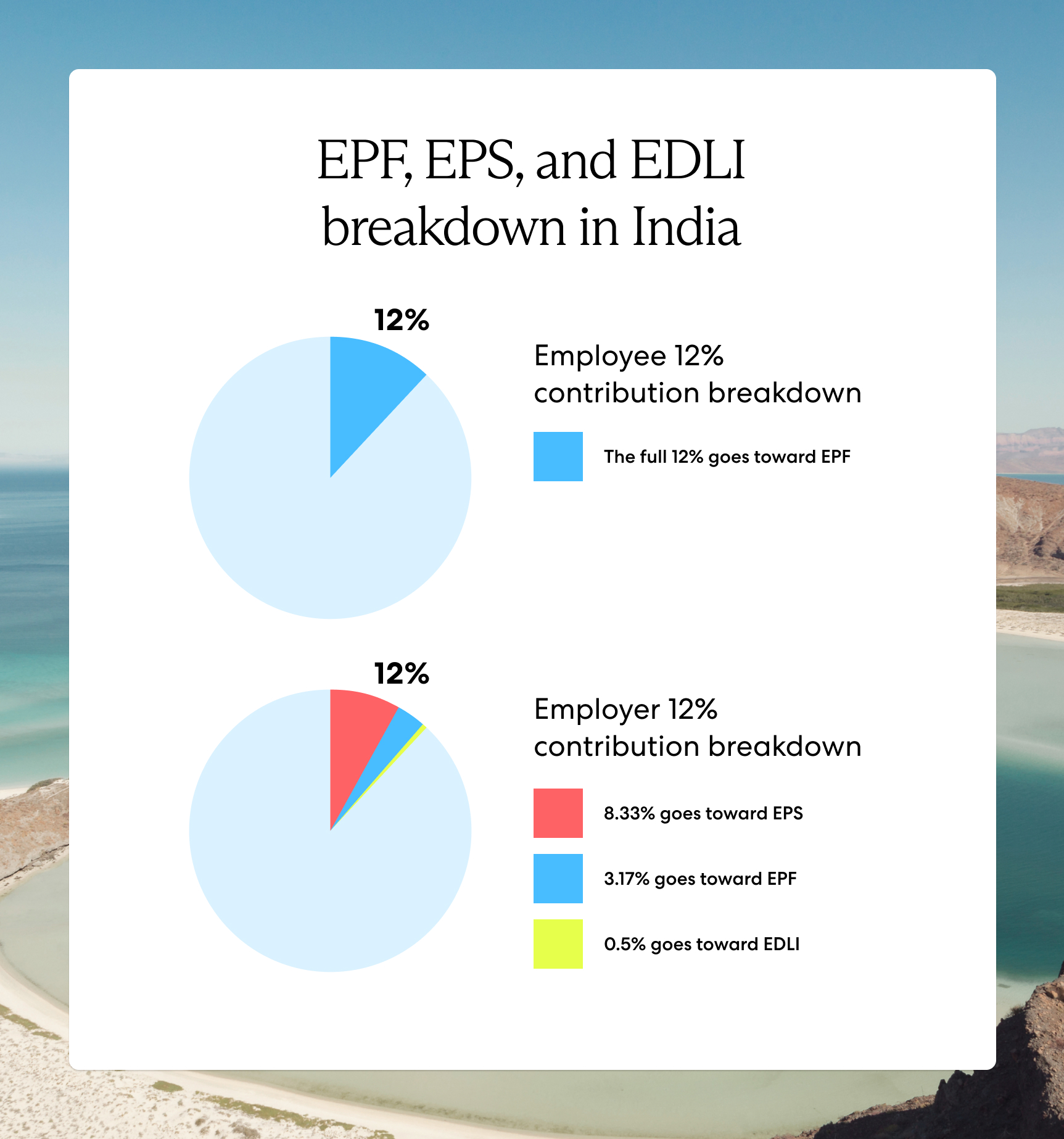Offering compliant, competitive benefits is critical for mitigating risk and fostering a healthy, happy, and productive team in any market. Yet, many global companies face unique challenges when administering employee benefits in India.
Cultural standards and employment regulations vary between states and industries, creating risks for foreign employers unfamiliar with local customs and laws. Remaining competitive and compliant while supporting a distributed workforce in India requires extra due diligence.
This guide provides a detailed breakdown of employee benefits in India. Find a list of the statutory benefits Indian employers must offer, and discover common supplementary benefits that can make your company an attractive landing spot for top local talent. Plus, learn how to simplify benefits administration for a global team.
What are the employee benefits in India?
Statutory employee benefits in India include Employees’ State Insurance (ESI), the Employees’ Provident Fund (EPF), the Employees’ Pension Scheme (EPS), Employees’ Deposit Linked Insurance (EDLI), gratuity rewards, paid leave, and national holidays. These programs cover healthcare, unemployment support, life insurance, maternity leave, and other benefits.
For example, the EPF and EPS provide retirement benefits and offer employees financial support for major purchases, such as buying a house or pursuing higher education. The ESI manages the state-backed healthcare program and offers income support for various covered life events, such as disability, vocational rehabilitation, and maternity leave.
However, many employers in India offer supplemental benefits on top of the statutory minimums. Additional benefits like vision and dental insurance fill coverage gaps, improve employee well-being, and help employers gain a competitive edge in the hiring market. Today, most employees in India expect their employers to offer supplemental benefits.
Common supplemental benefits in India include private medical insurance, private life insurance, paternity leave, and additional perks like transportation allowances, meal vouchers, and internet reimbursements.
Statutory employee benefits in India
Statutory employee benefits comprise the minimum benefits federal, state, and local regulators require employers to offer their employees. In India, these include ESI, EPF, EPS, EDLI, gratuity benefits, leave entitlements, and public holidays.
We take a closer look at each of these benefits programs below.
Employees’ State Insurance (ESI)
The ESI fund provides sickness, maternity, workplace injury, and medical coverage for qualifying employees in most industries nationwide. These include factories and establishments in the road transport, hotel, restaurant, cinema, newspaper, shop, educational, and medical sectors.
Any employee who earns under ₹21,000 (US$251) per month while working for a qualifying company that employs at least 10 or more employees is eligible for ESI benefits. Employers contribute 4.75% of their employees’ base earnings to the ESI fund, while employees pay 1.75%.
Employees’ Provident Fund (EPF)
The EPF is available to all employees in India. Its primary purpose is to provide financial assistance to employees under qualifying circumstances, such as buying a house, paying off a loan, or pursuing higher education.
However, employees can also wait to collect their EPF benefits as a lump sum upon retirement at 58. The EPF also provides income support for anyone unemployed for at least 60 days, and EPF benefits pass on to an employee’s dependents if the employee passes away.
The EPF is a tax-exempt, interest-bearing fund. In other words, all contributions to the EPF are tax-deductible, and the interest the fund earns and benefits employees receive are tax-free.
Employees and employers each contribute 12% of the employee’s gross monthly earnings to the EPF. Roughly eight percent (8.33%) of the employer’s contribution goes toward the EPS, an additional retirement fund for qualifying employees.
Employees’ Pension Scheme (EPS)
The EPS is a traditional pension fund functioning as a part of the EPF that provides regular monthly payments once an employee reaches the retirement age of 58. If a member passes away, their dependents receive the pension.
Unlike the EPF, the EPS fund does not accrue interest, and its benefits are taxable. Employees must have worked for at least 10 years to be eligible for their EPS pension, and the maximum pensionable salary they can receive under this program is ₹15,000 (US$180) monthly.
As previously mentioned, 8.33% of the employer’s EPF contributions fund the EPS. The federal government caps employer EPS contributions at ₹1,250 (US$15). Employees do not pay EPS tax.
Employees’ Deposit Linked Insurance (EDLI)
The EDLI is an automatic life insurance policy that also functions as a part of the EPF. In other words, any employee who has an EPF account automatically qualifies for EDLI benefits. Under EDLI provisions, each member establishes a registered nominee who receives a lump sum payment upon the member’s death.
EDLI benefits are 35 times the employee’s average monthly salary, with a minimum benefit of ₹250,000 (US$2,993) and a maximum of ₹700,000 (US$8,380). There is no minimum service period for nominees to qualify for EDLI benefits.
Employers contribute 0.5% of their employees’ gross monthly earnings to the EDLI fund, capped at ₹75 (US$0.90) per employee per month. Employees don’t pay into this fund.
Learn more about payroll taxes and contributions in India.

Gratuity benefits in India
Employees who have worked for their employer for over five years and retire, resign, or become disabled are eligible for a gratuity benefit, also known as a “thank you” gift, from their employer for their dedication to the company.
Gratuity payments amount to 15 days of monthly wages for every year of employment from the fifth year onward. Employers calculate gratuity payments using the following formula:
Total years of service minus five * gross monthly earnings * 15/26 (15 days’ wages out of 26 monthly working days)
Imagine an employee in India earns ₹30,000 (US$359) per month and has worked for their employer for 20 years, for instance. If they resign, the employer calculates the gratuity payment as follows: 15 * 30,000 * 15/26 = 259,615.
The employer must offer the employee a gratuity payment of ₹259,615 (US$3,108).
Leave entitlements in India
Leave entitlements vary drastically across India, depending on the state and industry in which an employee works. Still, many states implement similar terms for major provisions, such as vacation and sick leave.
Below, we provide average statutory leave entitlements nationwide:
- Vacation. Employees usually receive 15 days of paid annual vacation.
- Sick leave. Employees typically receive 12 days of paid annual sick leave.
- Maternity leave. Federal law requires all employers to offer pregnant employees 26 weeks of paid maternity leave for their first two children and 12 weeks for each subsequent child.
- Casual leave. Employees often receive six days of paid annual leave for unexpected, urgent personal events.
Statutory holidays in India
Employee benefits in India also include paid annual public holidays. Public holidays vary drastically between states, ranging from roughly 18 to 28 days per year, depending on the state. These include public and religious festivals such as Budh Purnima, Diwali, Good Friday, Dussehra, Christmas, Eid, and Guru Nanak Jayanthi.
However, federal regulations require all employers nationwide to offer paid leave on three national holidays: Republic Day on January 26, Independence Day on August 15, and Gandhi Jayanti (Gandhi’s Birthday) on October 2.
Supplemental employee benefits in India
While statutory employee benefits in India offer broad coverage, they still leave gaps, causing many employees to feel uncertain about their financial security and overall coverage needs.
By offering supplemental benefits, Indian employers can give their employees peace of mind, ensuring they have comprehensive coverage and a stable foundation for a quality life.
Supplemental benefits are an investment in your team and your business. Improving your employees’ health and well-being increases their engagement, productivity, and loyalty, resulting in more growth and innovation for your business.
Common supplemental employee benefits in India include additional medical insurance, life and accident insurance, paternity leave, and miscellaneous perks. We discuss each of these in detail below.
Download our essential global employee benefits guide to learn how to offer compliant, competitive benefits packages to talent in India and 185+ countries.

Private medical coverage
Additional private medical coverage is the most common supplemental benefit Indian employers offer their employees. These plans usually include supplemental vision, dental, accident, disability, hospital, and long-term care coverage and extend to include dependents and partners.
Private life insurance and AD&D plans
Many employers in India also offer their employees supplemental life and AD&D (accidental death and dismemberment) coverage.
Life and AD&D plans give employees peace of mind by knowing their dependents are financially covered if the employee experiences a major life event, such as death or serious injury, and cannot provide for them. Companies that offer this type of coverage stand out among local and international employers.
Paternity leave
While India’s public sector employees receive 15 days of paternity leave, no federal or state laws mandate this benefit in the private sector. Paternity leave is a relatively new and emerging benefit across India that gives fathers much-needed time to assist in child-rearing responsibilities at home and connect with their newborn or adopted children.
Eligibility criteria vary between companies, but most organizations require at least 80 days of service before qualifying for leave, and benefits are usually available to fathers of newborn and adopted children.
Employers in India usually offer two to three weeks of fully paid paternity leave. Still, leave durations and compensation rates vary, depending on individual company policies. Ultimately, it’s up to each organization to decide what is most appropriate for their team.
Additional supplemental perks
Employers in India also provide employees with additional perks, including nonwage fringe benefits, such as company cars, gym memberships, coworking spaces, or meal vouchers.
While employees in different Indian states expect different fringe benefits, common perks often include the following:
- Adoption assistance
- Remote work stipend
- Transportation allowance
- Meal vouchers
- Mobile or internet reimbursements
Supplemental perks provide a well-rounded approach to employee health and work-life balance and are a critical part of competitive global benefits packages.
Offer compliant and competitive employee benefits in India
Crafting benefits packages in India without legal guidance exposes you to serious compliance risks. Plus, you’ll face high turnover if you don’t meet local talent’s expectations. Simplify benefits administration and secure top Indian talent by partnering with Velocity Global.
Our Global Benefits solution makes it easy for companies of all sizes to offer cost-effective, compliant, market-specific benefits to employees in over 185 countries, including India.
We can create locally tailored benefits plans and ensure compliance while handling administration and governance on your behalf. This way, you can offer your Indian workforce the support they need without the added burden. Plus, with our own economies of scale, we offer access to competitive pricing on world-class supplemental and optional benefits.
Don’t let unfamiliar regulations, foreign customs, and high costs stop you from giving your Indian workforce what they need to thrive. Partner with Velocity Global to create a benefits strategy that can transform your workplace and fuel your success in India—contact us today to get started.
Disclaimer: The intent of this document is solely to provide general and preliminary information for private use. Do not rely on it as an alternative to legal, financial, taxation, or accountancy advice from an appropriately qualified professional. © 2024 Velocity Global, LLC. All rights reserved.
Topic:
Employee Benefits



